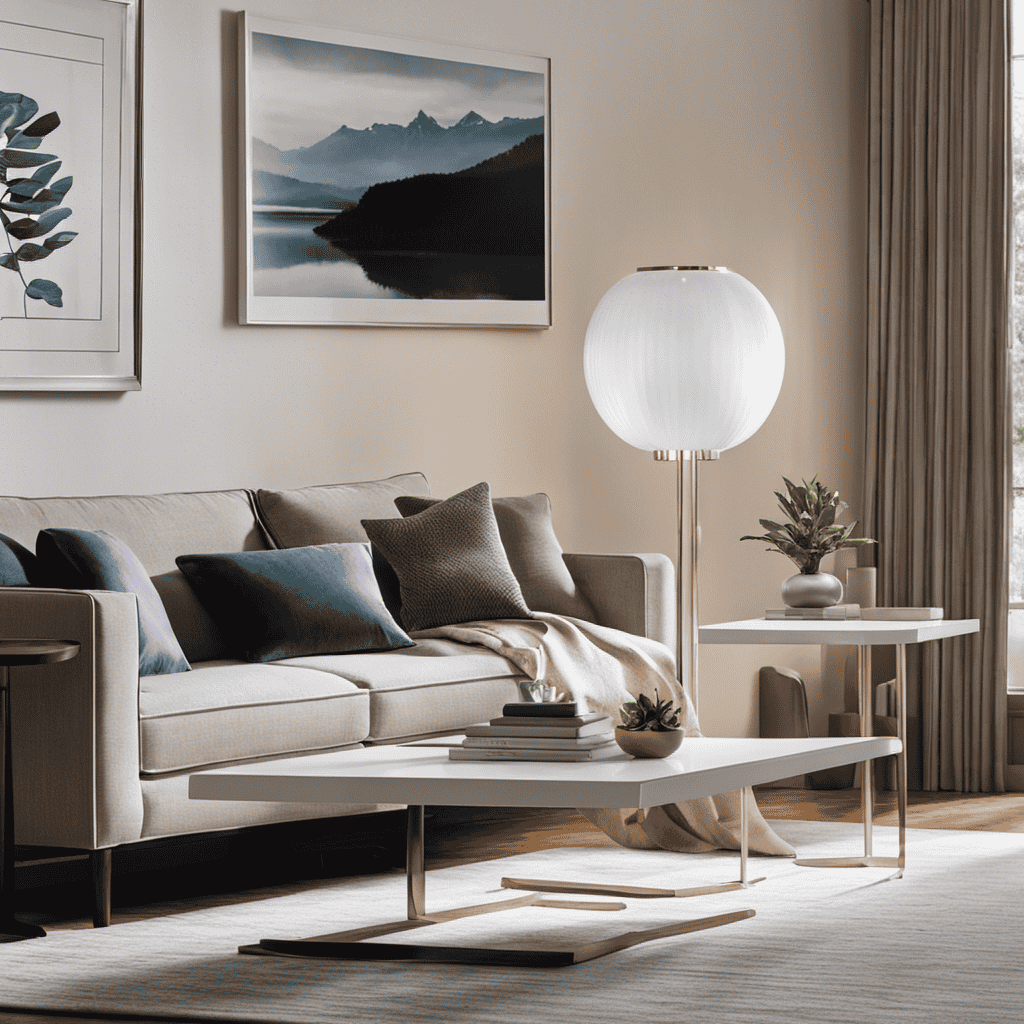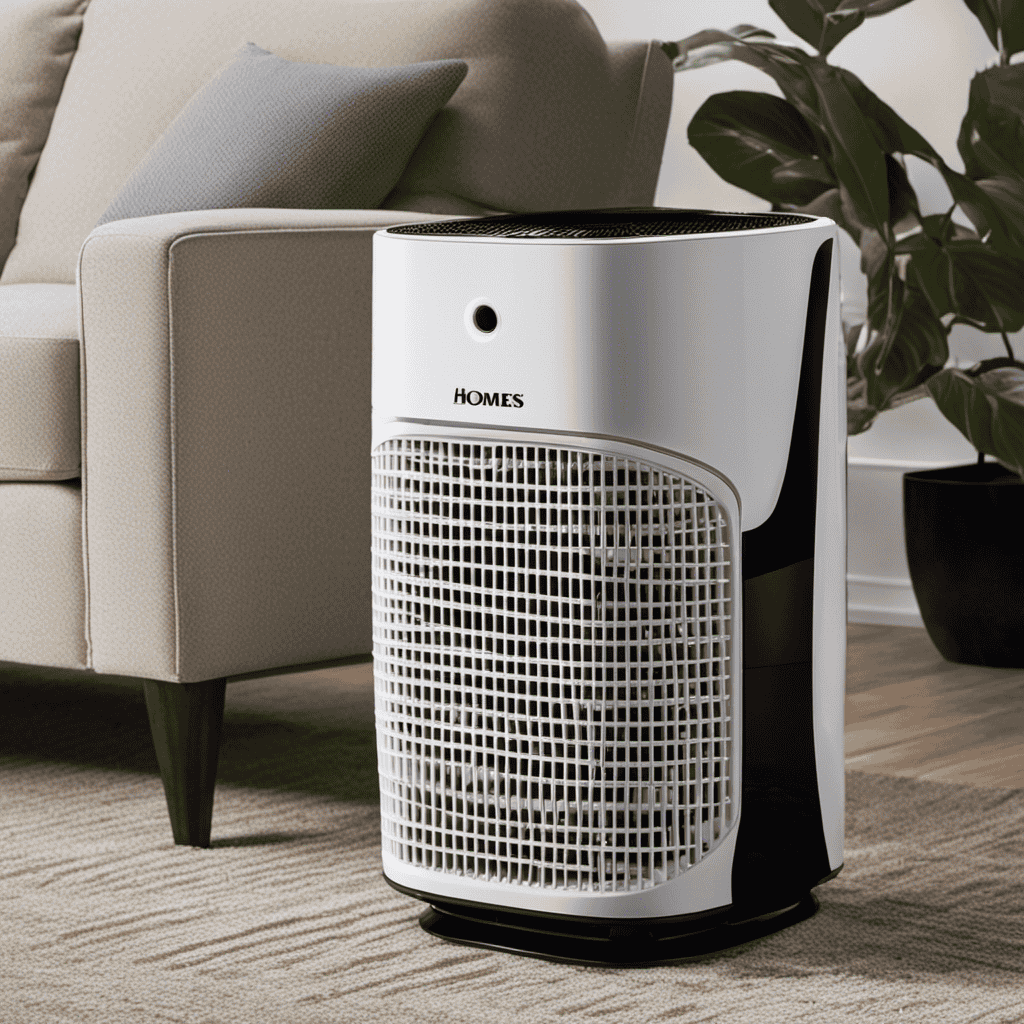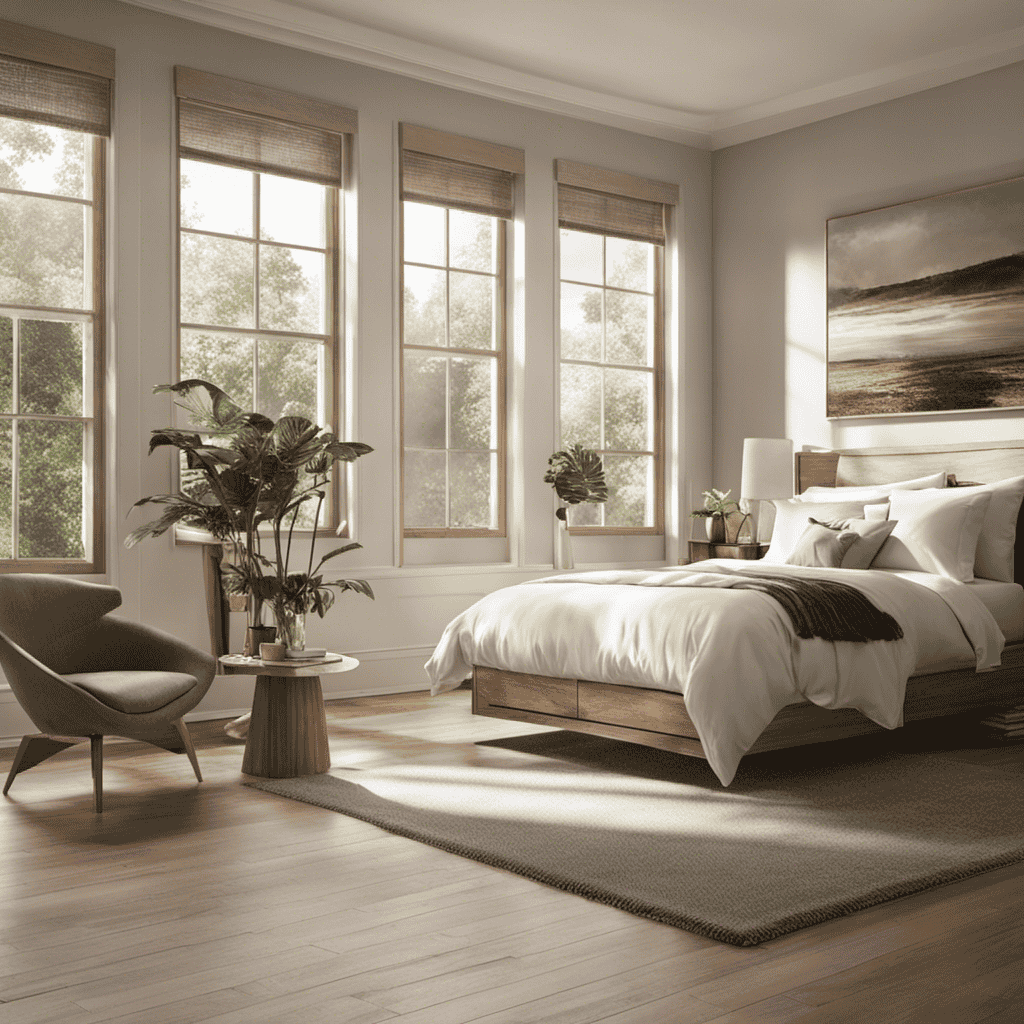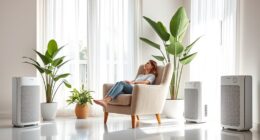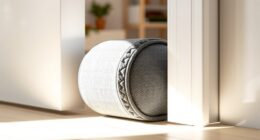I understand your thoughts – do I truly require an air purifier? Let me assure you, the answer is a definite yes.
With the increasing concerns about indoor air pollution and its impact on our health, having an air purifier has become more important than ever.
In this article, I will delve into the importance of air purifiers, how they work, and the benefits they bring to our lives.
So, let’s clear the air and discover why an air purifier should be a staple in every home.
Key Takeaways
- Air purifiers are essential for individuals with allergies or asthma, as they remove harmful airborne particles like dust, pollen, and pet dander.
- Different types of air purifiers use technologies like HEPA filters, activated carbon filters, and UV light to effectively eliminate pollutants and improve indoor air quality.
- Investing in an air purifier provides cleaner and healthier air, reducing the risk of respiratory infections and improving sleep quality and overall well-being.
- When choosing an air purifier, factors to consider include the size of the room, specific air pollutants to target, filter type and effectiveness, noise levels and operation, and regular maintenance and cleaning for optimal performance.
Importance of Air Purifiers
If you suffer from allergies or asthma, you should definitely consider getting an air purifier. Air purifiers have numerous benefits for individuals with respiratory conditions. These devices are designed to remove harmful airborne particles, such as dust, pollen, pet dander, and mold spores, from the indoor air. By doing so, they can significantly reduce allergens and irritants that trigger allergy or asthma symptoms.
Furthermore, air purifiers utilize various technologies to effectively clean the air. Some common technologies include HEPA filters, which can capture particles as small as 0.3 microns, and activated carbon filters, which can eliminate odors and harmful gases. These technologies work together to create a healthier indoor environment.
Now that we understand the importance of air purifiers, let’s explore the different types available in the market.
Types of Air Purifiers
When looking for an air purifier, you’ll find various types to choose from. These types differ primarily in the filters they use, as well as their size and coverage capabilities.
One common type of filter used in air purifiers is the High-Efficiency Particulate Air (HEPA) filter. HEPA filters are effective at removing particles as small as 0.3 micrometers, capturing allergens, pollen, and dust mites.
Another type of filter is the activated carbon filter, which helps remove odors, gases, and volatile organic compounds (VOCs) from the air. Some air purifiers also use ultraviolet (UV) light to kill bacteria and viruses.
When selecting an air purifier, it is important to consider the size of your space and the coverage area of the purifier to ensure effective air cleaning. Understanding the different types of filters and their capabilities is crucial in making an informed decision about which air purifier is best suited for your needs.
Now that we have explored the types of air purifiers available, let’s delve into how these devices actually work to improve indoor air quality.
How Air Purifiers Work
As an expert in air quality, I’m excited to discuss how air purifiers work and the mechanisms they use to filter pollutants. Understanding these filtration mechanisms is crucial in appreciating the benefits of clean air that air purifiers provide.
Air purifiers effectively remove a wide range of pollutants such as dust, pollen, pet dander, and even volatile organic compounds (VOCs). They play a vital role in improving indoor air quality and promoting better health for individuals.
Filtration Mechanisms Explained
To understand how an air purifier works, you need to know about its filtration mechanisms. Air purifiers use various filtration techniques to remove contaminants from the air, improving indoor air quality. One common misconception is that air purifiers simply blow air around, but in reality, they actively filter out pollutants. The table below illustrates the filtration mechanisms commonly found in air purifiers:
| Filtration Mechanism | Description | Effectiveness |
|---|---|---|
| Pre-filter | Captures large particles like dust and hair. | High |
| HEPA filter | Removes small particles such as allergens and smoke. | Very high |
| Activated carbon filter | Absorbs odors, chemicals, and gases. | Moderate |
| UV-C light | Kills bacteria and viruses. | High |
Understanding the filtration mechanisms of an air purifier is crucial in selecting the right one for your needs. By debunking common misconceptions and relying on evidence-based information, we can make informed decisions for cleaner and healthier indoor air.
Benefits of Clean Air
Having clean indoor air can greatly improve your overall health and well-being. As someone who has experienced the benefits of clean air firsthand, I can attest to its importance.
Here are three reasons why clean air is vital for a healthy living environment:
-
Reduces Allergens: Air purifiers help to remove allergens such as pollen, dust mites, and pet dander from the air. This is especially beneficial for individuals with allergies or asthma, as it can alleviate symptoms and improve breathing.
-
Eliminates Harmful Particles: Indoor air can contain harmful particles like bacteria, viruses, and volatile organic compounds (VOCs). Air purifiers with HEPA filters can effectively trap and remove these particles, reducing the risk of respiratory infections and other health issues.
-
Improves Sleep Quality: Breathing in clean air while sleeping can lead to better sleep quality and overall well-being. Air purifiers help to remove airborne pollutants that can disrupt sleep, allowing you to wake up feeling refreshed and rejuvenated.
Investing in an air purifier is a wise decision for anyone looking to improve their indoor air quality and reap the benefits of clean air.
Types of Pollutants Removed
You’ll be surprised by the different types of pollutants that can be effectively removed from your indoor environment with the help of an air purifier. Air pollution is a serious issue, and understanding the sources of pollutants is crucial for effective air pollution control. Common sources of indoor pollutants include tobacco smoke, pet dander, dust mites, pollen, mold spores, and volatile organic compounds (VOCs) emitted by household products. An air purifier can efficiently remove these pollutants, providing cleaner and healthier air for you and your family.
Here is a table outlining the different types of pollutants and their sources:
| Pollutant | Sources |
|---|---|
| Tobacco smoke | Cigarettes, cigars, and pipes |
| Pet dander | Shedding of animal fur or feathers |
| Dust mites | Dust and textiles |
| Pollen | Plants and trees |
| Mold spores | Moisture and damp areas |
| VOCs | Cleaning products, paints, and solvents |
Using an air purifier can effectively remove these pollutants, improving the air quality in your home and reducing the risks associated with exposure to these harmful substances.
Benefits of Using an Air Purifier
Using an air purifier can greatly improve the air quality in your home. Not only does it filter out harmful pollutants, but it also provides long-term health benefits.
Here are three ways in which an air purifier can be effective:
-
Removes allergens: Air purifiers can capture and remove allergens such as pollen, dust mites, and pet dander. This can significantly reduce allergy symptoms and improve overall respiratory health.
-
Eliminates harmful chemicals: Air purifiers equipped with activated carbon filters can effectively remove volatile organic compounds (VOCs) and other harmful chemicals present in the air. This helps create a healthier living environment and reduces the risk of long-term health issues.
-
Reduces the spread of airborne diseases: Air purifiers with germicidal filters can eliminate bacteria, viruses, and other pathogens from the air. This can help prevent the transmission of airborne diseases and protect the health of you and your family.
Investing in an air purifier is a proactive step towards improving indoor air quality and reaping long-term health benefits.
Common Air Pollutants
When it comes to understanding air pollution, it is crucial to have a clear understanding of the types of pollutants that are commonly found in the environment. These pollutants can range from harmful gases like carbon monoxide and sulfur dioxide to particulate matter such as dust and pollen.
Furthermore, it is important to recognize the health effects that pollution can have on individuals, including respiratory issues, cardiovascular problems, and even cancer.
To combat these negative effects, effective air purification methods are essential. These methods include using high-efficiency particulate air (HEPA) filters or activated carbon filters to remove pollutants from the air we breathe.
Types of Pollutants
There are different types of pollutants that can be removed by an air purifier. Airborne contaminants can come from various sources of pollution, both indoors and outdoors. Here are three common types of pollutants that an air purifier can help remove:
-
Particulate Matter: These are tiny particles suspended in the air, such as dust, pollen, pet dander, and mold spores. They can cause respiratory issues and allergies.
-
Volatile Organic Compounds (VOCs): These are chemicals emitted from products like cleaning supplies, paints, and furniture. They can cause headaches, nausea, and eye irritation.
-
Gaseous Pollutants: These include pollutants like carbon monoxide, nitrogen dioxide, and ozone. They can come from sources such as gas stoves, tobacco smoke, and vehicle emissions. Exposure to these pollutants can have harmful effects on our health.
An air purifier with the right filters and technologies can effectively capture and remove these pollutants from the air, providing cleaner and healthier indoor environments.
Health Effects of Pollution
Exposure to pollutants can have harmful effects on our health, such as respiratory issues, allergies, headaches, nausea, and eye irritation.
Air pollution is a significant concern worldwide, affecting millions of people and causing numerous health problems. Particulate matter, volatile organic compounds, and nitrogen dioxide are some of the common pollutants that can have detrimental effects on respiratory health. These pollutants can irritate the airways, leading to asthma, bronchitis, and other respiratory conditions. Long-term exposure to air pollution has also been linked to an increased risk of lung cancer and cardiovascular diseases.
It is crucial to implement air pollution solutions to protect our respiratory health. This includes reducing emissions from industries and vehicles, promoting the use of clean energy sources, and improving indoor air quality through the use of air purifiers and proper ventilation systems.
Effective Air Purification
Implementing effective air purification solutions can significantly improve indoor air quality and create a safer environment for everyone. Clean air benefits are numerous and include reducing the risk of respiratory diseases, allergies, and other health issues.
Here are three air purification techniques that can help achieve clean air:
-
HEPA filtration: High Efficiency Particulate Air (HEPA) filters can capture up to 99.97% of airborne particles, including dust, pollen, mold spores, and pet dander.
-
Activated carbon filters: These filters can remove volatile organic compounds (VOCs), odors, and harmful gases from the air, providing a fresher and cleaner environment.
-
UV-C light technology: Ultraviolet (UV) light can destroy the DNA and RNA of microorganisms like bacteria and viruses, effectively eliminating them from the air.
Factors to Consider When Choosing an Air Purifier
When choosing an air purifier, it’s important to consider factors such as the size of the room and the specific air pollutants you want to target.
The size of the room is crucial because it determines the capacity of the air purifier needed to effectively clean the air. A larger room would require a purifier with a higher Clean Air Delivery Rate (CADR) to ensure optimal performance.
Additionally, identifying the specific air pollutants you want to eliminate is essential. Different purifiers are designed to target different types of pollutants, such as dust, pollen, pet dander, or smoke.
Considering these factors will help you choose an air purifier that best suits your needs and ensures cleaner, healthier air in your home.
Now, let’s explore the key features of air purifiers.
Key Features of Air Purifiers
When it comes to choosing an air purifier, there are several key features to consider.
First and foremost is the filter type and effectiveness. Different air purifiers use different types of filters, such as HEPA filters or activated carbon filters, which vary in their ability to capture and remove pollutants from the air.
Additionally, it’s important to consider the noise levels and operation of the air purifier, as you want a device that effectively cleans the air without causing excessive noise or disruption.
Filter Types and Effectiveness
The effectiveness of air purifiers varies depending on the type of filter used. Proper filter maintenance is essential to ensure optimal performance and reap the full benefits of an air purifier.
Here are three types of filters commonly used in air purifiers:
-
HEPA (High-Efficiency Particulate Air) Filters: These filters capture 99.97% of particles as small as 0.3 microns, including dust, pollen, pet dander, and mold spores. Regularly replacing or cleaning the HEPA filter is crucial for maintaining its effectiveness.
-
Activated Carbon Filters: These filters are excellent at removing odors, chemicals, and volatile organic compounds (VOCs) from the air. However, they have limited efficiency in capturing particles. Activated carbon filters usually need replacement every few months.
-
Electrostatic Filters: These filters use an electric charge to attract and trap particles. They are washable and reusable, but their efficiency may decrease over time.
By regularly maintaining the filters, air purifiers can effectively improve indoor air quality and provide numerous health benefits.
In the next section, we will explore the impact of noise levels and operation on air purifiers.
Noise Levels and Operation
To reduce noise levels and optimize operation, make sure to place the air purifier on a stable surface and avoid obstructing the vents. A noisy air purifier can be disruptive and affect your comfort, especially if you plan to use it in your bedroom or office. When it comes to air purifier noise, it’s important to choose a model that operates quietly. Look for units with low decibel levels, typically below 50 dB. Additionally, consider the placement of the air purifier in your space. Placing it on a stable surface, away from walls or furniture, can help minimize vibrations and further reduce noise.
| Noise Level (dB) | Noise Description |
|---|---|
| Below 30 | Whisper quiet |
| 30-40 | Background noise |
| 40-50 | Light conversation |
| Above 50 | Noticeable noise |
Best Places to Use an Air Purifier
You’ll want to consider using an air purifier in rooms where you spend the most time. Air purifiers are effective in improving indoor air quality by removing pollutants and allergens.
Here are three places where an air purifier can be especially beneficial:
-
Bedroom: Since we spend a significant amount of time sleeping, it’s important to ensure clean air in our bedrooms. An air purifier can help eliminate dust mites, pet dander, and other airborne particles that can affect our sleep quality and respiratory health.
-
Living room: This is where we often gather with family and friends. An air purifier can help reduce the presence of pollutants such as smoke, odors, and volatile organic compounds (VOCs) from cleaning products or furniture, creating a healthier and more pleasant environment.
-
Home office: If you work from home, having clean air in your workspace is crucial. An air purifier can help eliminate allergens, mold spores, and other pollutants that may be present in the indoor air, improving your focus and productivity.
When deciding to use an air purifier, it’s important to consider factors such as filter maintenance and cost effectiveness. Regularly cleaning or replacing the filters will ensure optimal performance and longevity of the device. Additionally, choosing an air purifier that is energy-efficient and has a reasonable price point can make it a cost-effective investment in the long run.
Maintenance and Cleaning of Air Purifiers
Make sure to regularly clean or replace the filters in your air purifier to maintain its optimal performance. Air purifiers are effective in removing pollutants and allergens from the air, but they require proper maintenance to continue working efficiently.
Cleaning the filters is essential as they trap dust, pollen, pet dander, and other airborne particles. To clean the filters, follow the manufacturer’s instructions, which usually involve vacuuming or rinsing them. Some filters may also be washable.
Additionally, it is important to regularly clean the exterior of the air purifier to remove any accumulated dust or dirt. By properly maintaining and cleaning your air purifier, you can ensure that it continues to provide clean and fresh air for your home or office.
Now, let’s explore the signs that indicate you may need an air purifier.
Signs That You Need an Air Purifier
As an expert in indoor air quality, I have witnessed firsthand the impact that poor air quality can have on individuals.
Allergy symptoms, such as sneezing, coughing, and itchy eyes, are often an indication that the air in your home is filled with allergens and pollutants.
These symptoms can be exacerbated by indoor air quality problems, such as high levels of dust, pet dander, or mold spores.
Allergy Symptoms Indication
Feeling congested and sneezing frequently are common signs that you might be experiencing allergy symptoms. Allergies occur when your immune system reacts to a substance, known as an allergen, that is usually harmless. To alleviate these symptoms, you can try allergen avoidance and natural remedies.
Here are three effective ways to manage your allergies naturally:
-
Keep your home clean: Regularly dust and vacuum to remove allergens like dust mites and pet dander from your living space.
-
Use saline nasal irrigation: This can help flush out allergens and reduce nasal congestion.
-
Try herbal remedies: Certain herbs, such as nettle leaf and butterbur, have been shown to have antihistamine properties and can provide relief from allergy symptoms.
By implementing these strategies, you can reduce your exposure to allergens and find relief from your allergy symptoms. However, if your symptoms persist or worsen, it is important to consult a healthcare professional for further evaluation and treatment options.
Ensuring good indoor air quality is crucial in managing allergies and other respiratory issues.
Indoor Air Quality Problems
After learning about the various symptoms that indicate allergies, it is important to understand the underlying causes of indoor air quality problems.
Indoor air pollution refers to the presence of harmful pollutants in the air we breathe inside our homes or buildings. These pollutants can come from a variety of sources, including dust, pet dander, mold spores, tobacco smoke, cleaning products, and volatile organic compounds (VOCs) emitted by furniture and building materials.
Exposure to indoor air pollution poses significant health risks. Studies have shown that poor indoor air quality can lead to respiratory problems such as asthma and allergies, as well as other health issues including headaches, fatigue, and eye irritation. Long-term exposure to certain pollutants, such as asbestos or radon, can even increase the risk of developing more serious conditions like lung cancer.
To protect our health and improve indoor air quality, it is essential to address the sources of pollution and consider using air purifiers.
Air Purifiers Vs. Other Air Cleaning Methods
Air purifiers are more effective than other air cleaning methods in removing particles and allergens from the air. Here’s why:
- Air purifiers vs. plants:
- Air purifiers are specifically designed to capture and eliminate airborne particles, while plants primarily help improve air quality through photosynthesis and oxygen production.
- Air purifiers can filter out a wide range of pollutants, including pollen, dust, pet dander, and mold spores, whereas plants have limited capabilities in removing these specific allergens.
- Air purifiers can operate continuously and efficiently, ensuring consistent air purification, while plants require sunlight, water, and maintenance to thrive and contribute to air quality.
- Air purifiers vs. HVAC systems:
- Air purifiers target pollutants directly at the source, whereas HVAC systems focus on temperature regulation and air circulation.
- Air purifiers can effectively remove smaller particles, such as bacteria and viruses, which HVAC systems may not be able to capture.
- Air purifiers can be portable and used in specific areas, providing localized air purification, while HVAC systems cover larger spaces and may not provide the same level of purification.
Understanding Air Quality Index (AQI
To better understand the current air quality, you should check the Air Quality Index (AQI) regularly. Monitoring air quality is of utmost importance as it directly impacts our health and well-being.
The AQI provides a standardized way to measure and report air quality levels based on various pollutants such as particulate matter, ozone, carbon monoxide, and sulfur dioxide. By regularly checking the AQI, we can stay informed about the quality of the air we breathe and take necessary precautions if the air quality is poor.
The role of the government in improving air quality is crucial. They implement policies and regulations to reduce pollution, promote clean energy sources, and ensure compliance with environmental standards.
Transitioning into the next section, let’s now explore how we can improve indoor air quality.
How to Improve Indoor Air Quality
You can improve indoor air quality by regularly cleaning and vacuuming your living space. Dust, allergens, and pollutants can accumulate in your home and impact your health.
Here are three ways to further enhance the air you breathe:
-
Improve ventilation: Open windows and doors to allow fresh air to circulate in your home. This helps remove stale air and improves air exchange.
-
Use natural air purifiers: Certain plants, such as aloe vera, spider plants, and peace lilies, can help remove toxins from the air. These plants act as natural air purifiers and can make a significant difference in indoor air quality.
-
Keep your living space clean: Regularly dust surfaces, vacuum carpets, and mop floors to reduce the buildup of allergens and pollutants. This simple step can have a big impact on the air you breathe.
Myths About Air Purifiers
Now that we have discussed how to improve indoor air quality, let’s turn our attention to debunking some common myths about air purifiers. It is important to understand the effectiveness of air purifiers so that we can make informed decisions about our indoor environments.
One common myth is that air purifiers can completely eliminate all pollutants in the air. While air purifiers can certainly help reduce the concentration of pollutants, they cannot completely eliminate them. It is also important to note that different air purifiers are designed to target specific pollutants, such as dust, pollen, or pet dander. Therefore, it is crucial to choose an air purifier that suits your specific needs.
Another myth is that air purifiers can cure respiratory conditions such as asthma or allergies. While air purifiers can help alleviate symptoms by reducing the presence of allergens in the air, they cannot cure these conditions. It is important to consult with a medical professional for appropriate treatment.
Choosing the Right Air Purifier for Your Needs
When considering which air purifier is right for your needs, take into account factors such as the size of the room and the specific pollutants you want to target.
Here are three important considerations to keep in mind when choosing an air purifier:
-
Room Size: The size of the room is crucial in determining the appropriate air purifier. Different air purifiers have different coverage areas, so make sure to choose one that can effectively clean the air in your specific room size.
-
Pollutant Types: Identify the specific pollutants you want to target. Some air purifiers are designed to remove allergens like pollen and pet dander, while others excel at capturing smoke or odors. Understanding your specific needs will help you select the right air purifier.
-
Brand and Cost: Research reputable air purifier brands that have a track record of producing quality products. Consider the cost of the air purifier and factor in additional expenses like filter replacements. Remember, investing in a reliable and efficient air purifier will provide long-term benefits for your health and well-being.
Frequently Asked Questions
Are Air Purifiers Effective in Removing Pet Dander and Allergens?
Yes, air purifiers are effective in reducing pet dander and allergens. They can remove pollen and dust particles, making the air cleaner for pet owners. Different types of air purifiers vary in effectiveness, so research is important.
Can Air Purifiers Eliminate Odors and Smoke Particles From the Air?
Yes, air purifiers can eliminate odors and smoke particles from the air. Regular maintenance is important for optimal performance. Using an air purifier has many benefits, such as improving indoor air quality and reducing respiratory issues.
Is It Necessary to Run an Air Purifier Continuously, or Can It Be Used Intermittently?
It’s important to run an air purifier continuously for optimal air quality. Regular maintenance, such as changing filters, ensures its effectiveness. The benefits of using an air purifier include reducing allergens, pollutants, and improving overall respiratory health.
Do Air Purifiers Help With Respiratory Conditions Like Asthma and Allergies?
Yes, air purifiers can help with respiratory conditions like asthma and allergies. They remove allergens and irritants from the air, providing cleaner and healthier indoor air. Regular maintenance is important for optimal air purifier benefits.
How Often Should the Filters in an Air Purifier Be Replaced?
When it comes to air purifiers, one important factor to consider is how often the filters should be replaced. Regular filter replacements ensure optimal performance and clean air.
Conclusion
In conclusion, after conducting thorough research and investigating the truth of various theories, it is clear that air purifiers play a crucial role in improving indoor air quality.
They effectively remove common air pollutants, such as dust, pollen, and pet dander, leading to a healthier living environment.
The different types of air purifiers, including HEPA filters and activated carbon filters, work together to capture and eliminate harmful particles.
By understanding the Air Quality Index (AQI) and following guidelines to improve indoor air quality, we can ensure a safer and cleaner environment for ourselves and our loved ones.
